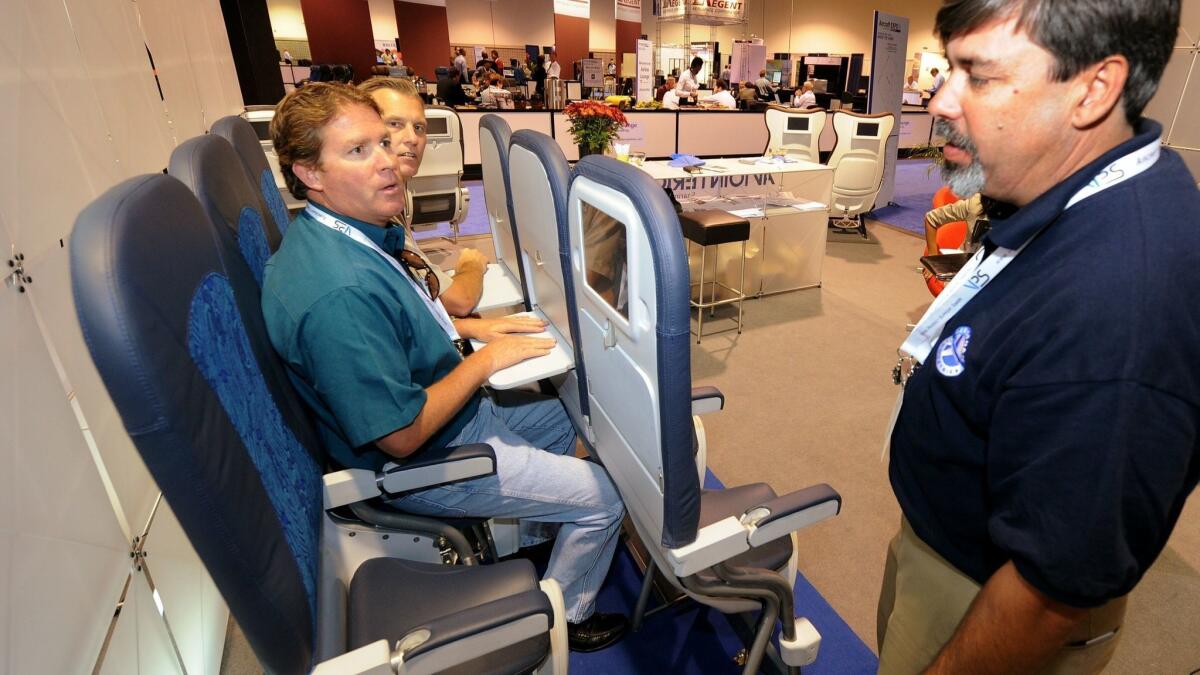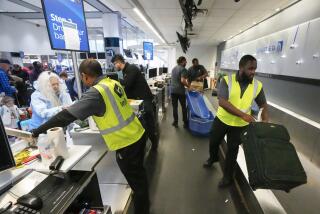Column: The airlines want a bailout? Give us more legroom in return

“My style of deal-making is quite simple and straightforward. I aim very high, and then I just keep pushing and pushing and pushing to get what I’m after.”
― Donald Trump, “The Art of the Deal”
The Trump administration this week called for $850 billion in taxpayer funds to boost the economy during the coronavirus pandemic.
This isn’t a bad idea in and of itself. There’s a long history of governments worldwide responding to extraordinary times with measures to protect the overall economy and favored industries.
When it comes to handing billions of dollars to struggling airlines, however, let’s stop for a moment and ask whether President Trump, who fancies himself a master negotiator, is giving away the store and seeking little if anything in return.
“We’re going to back the airlines 100% — it’s not their fault,” Trump said, adopting the bargaining position of an ATM.
Here’s a thought: If we’re going to throw a ton of money at this industry, why don’t we demand a few things in return?
Like, say, telling carriers that if they want billions of dollars in taxpayer cash, they have to remove a few rows from coach and give everyone more legroom.
Like, say, telling them they have to get rid of baggage fees.
Like, say, telling them they have to do away with all those other nickel-and-dime fees that have become the bane of passengers. I mean, a fee for families to sit together? Are you kidding?
And do the airlines really deserve our pity?
They’ve steadily reduced competition through a seemingly endless series of mergers, giving them virtually unchecked ability to raise fares and impose additional charges.
All the while, carriers buttered their own bread by taking record profits and using the money in part for stock buybacks — a move intended solely to keep shareholders happy at the expense of customers.
American Airlines reportedly spent more than $15 billion from 2014 to 2020 buying back its own stock and inflating the company’s shareholder value.
As a result of such behavior, the airlines now have precious few cash reserves and growing debt.
Maybe if they’d treated customers better since the last time they passed the hat, after the 9/11 attacks, their woe-is-us neediness this time around wouldn’t be so grating.
The reality is they’ve padded their own pockets while making passengers — particularly those flying coach — feel as miserable and unwelcome as possible.
Baggage fees of $40, change fees of $200 for domestic flights, hundreds more for international routes. Cutbacks or elimination of all the little amenities that once made air travel more palatable.
And don’t get me started on the seats, which have been transformed over the years from flying armchairs to torture devices for all but circus contortionists.
Airlines try to obscure passenger discomfort by talking about “seat pitch.” That’s the distance from a point on one seat to the same point on the seat before it.
In the real world, what they’re talking about is legroom, how little space there may be to lower your tray table and how close to your face that seat ahead of you will be when reclined.
Seat pitch in most coach sections is between 28 and 34 inches. The width of the seat cushion under your tush could be as little as 17 inches.
Business class seats typically have more than 60 inches of pitch and cushions wider than 20 inches.
As I noted in a column last year, the airline industry has been focused for a while now on even crueler treatment of coach passengers. Delta Air Lines experimented on some routes with seats that barely recline.
Then there’s the Skyrider “standing seat,” which was unveiled at the Aircraft Interiors Expo 2019 trade show in Hamburg, Germany.
Picture a bicycle saddle with a back rest. Its seat pitch — again, the distance to the same point on the seat in front of you — is a malevolent 23 inches.
This is a real product that is being marketed to airlines around the globe.
To the best of my knowledge, no carrier has yet mustered the courage to inflict the Skyrider on short-haul travelers. But the mere fact that something so mean-spirited is an actual thing tells you how the wind was blowing — at least until now.
Airlines for America, a trade group, said this week that the industry needs at least $29 billion in financial assistance and as much as $29 billion more in low-interest loans or loan guarantees.
They also want a halt to federal excise taxes on fuel, cargo and airline tickets through the end of next year.
“The current economic environment is simply not sustainable, and it is compounded by the fact that the crisis does not appear to have an end in sight,” the group said, calling the pandemic an “unprecedented economic downfall.”
Roger Dow, chief executive of the U.S. Travel Assn., chimed in by saying, “This situation is completely without precedent.”
There’s nothing unprecedented about riding to the rescue of ailing industries.
Billions have been lavished over the years on, among other recipients, the auto industry, the Federal National Mortgage Assn. and Federal Home Loan Mortgage Corp. (Fannie Mae and Freddie Mac), insurance giant AIG and, of course, airlines.
This time around, there’s a decidedly distasteful aspect to the idea that airline bailouts are being engineered by a president who remains heavily invested in, and profits from, the international hospitality business.
Trump needs airlines to get visitors to his hotels, resorts and golf courses around the world. A spate of bankruptcies among carriers would be bad for the industry in general and bad for Trump in particular.
This is why all other modern presidents — all of them, Republican and Democrat — severed ties with their business interests upon taking office.
However, if we are going to keep the airline industry aloft, let’s not look like chumps in doing so.
Mr. Art of the Deal, who proudly says he isn’t afraid to push and push and push to get what he wants, shouldn’t hesitate to ask the airlines what they’re going to do in return for our help.
If the airline CEOs can’t imagine what he means by that, here’s the response: “You increase seat pitch and width for all coach seats. You eliminate most fees, but especially baggage fees. You stop taking customers for granted.”
Or next time, maybe there won’t be a next time.
More to Read
Inside the business of entertainment
The Wide Shot brings you news, analysis and insights on everything from streaming wars to production — and what it all means for the future.
You may occasionally receive promotional content from the Los Angeles Times.











